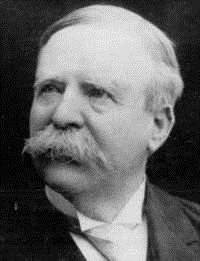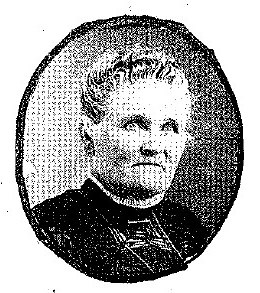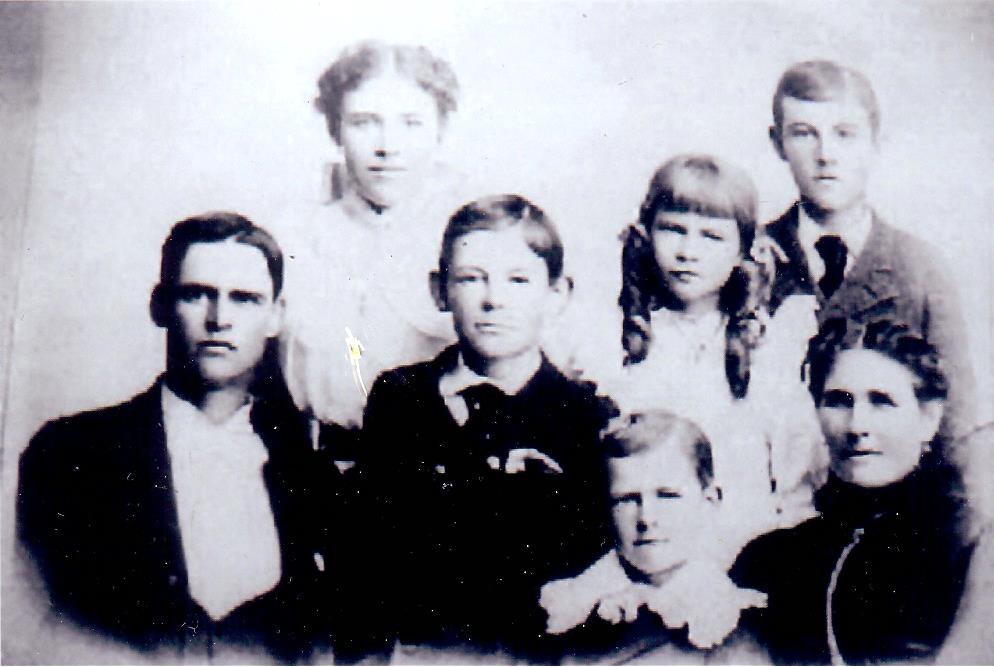
WASHINGTON COUNTY HISTORICAL SOCIETY (Washington County, Utah)
THOMAS JUDD
(businessman in St. George)
BIOGRAPHY
Thomas Judd was born September 1, 1845 in Birkenhead, Chestershire, England.His parents joined the Mormon Church and emigrated to Utah, his father traveling first in 1862 to earn the money to bring the family. His mother and seven children followed in 1864; the two youngest children died on the trip.
Thomas Judd was 18 years old in 1864 when he was baptized a member of the Church of Jesus Christ of Latter-day Saints. Thomas settled in Utah's Dixie. He worked hard and became a prominent businessman and church leader.
Mary Jane Ashworth was born October 23, 1849 in Saint Louis, Missouri. Thomas married her on October 3, 1870 in the Salt Lake Temple. They had ten children, six of whom lived past infancy.
Thomas was a bugler in the Navajo Indian War from 1866-1870.
Soon after arriving in St. George, Thomas Judd became the clerk of the Southern Utah Tithing Office. He soon built the home at 269 South 200 East in St. George in 1875-76.
In October 1875 Judd joined his financial resources with those of Edwin Gordon Woolley and Robert C. Lund to establish the firm of Woolley, Lund and Judd. Their store proved so successful that it presented a threat to the recently established Southern Utah Cooperative Mercantile Institution founded by Apostle Erastus Snow also in 1875. The Southern Utah CMI was part of the Church-wide cooperative movement to develop a self-sufficient economy thereby excluding the threat of economic domination by non-Mormons. As an apparent result of the rivalry, all three partners were called on proselyting missions during the Semi-Annual Church Conference in April 1876. Not without some influence on Brigham Young, the three men worked out a compromise whereby Edwin Woolley would serve a mission in the United States, Thomas Judd would return to his native land of England to try to win converts to the Mormon faith and Robert Lund would be permitted to remain in Utah to operate the business.
After a two-year sojourn in the mission field from 1876 to 1878, Woolley and Judd returned home. The silver mining boom at nearby Silver Reef provided and excellent opportunity to expand the operations of the firm and store was opened in the building which also housed the local offices of Wells Fargo and Company. With stores in St. George and Silver Reef, the firm played an important role in the economy of Southern Utah.
Looking to expand his business interests and alarmed that frequent flooding was washing away valuable river-bottom farm land, in 1888 he developed a plan to divert water from the Virgin River onto the LaVerkin "bench" in order to irrigate several hundred acres of fruit orchards that he planned to plant there. Because of extensive delays due to constant breaks in the canal he was eventually forced to mortgage his St. George house in order to raise the necessary funds to complete construction of his canal, which by then stretched several thousand feet and included an 840-foot long tunnel. Eventually his canal project was the key factor in establishing the community of LaVerkin.
Expanding from his success in the firm of Woolley, Lund and Judd, Thomas Judd became involved in the development of the region's agricultural and horticultural potential. In 1865 a Gardener's Club of St. George was organized for the purpose of encouraging local fruit and vegetable production by dissiminating information on profitable techniques and potential hazards in crop production. Throughout the 1860's and 1870's, Joseph E. Johnson was the primary force behind the club's activities. According to the historian A. Karl Larson, "It would probably be no mistake to say that he [Joseph E. Johnson] contributed more to the development of the pioneer fruit industry in Dixie than any other person." (Andrew Karl Larson, I Was Called to Dixie, p. 336.) The Gardener Club lost its vitality during the 1880's, but in 1888 it was revived with the organization of the St. George Farmers' and Gardeners' Club. Thomas Judd was elected president of the Club and A. Karl Larson in comparing Judd's importance with that of Joseph E. Johnson, the father of the Dixie fruit industry, concludes, "What Joseph E. Johnson was to St. George in an earlier generation, Thomas Judd was to the period of the late Eighties and the Nineties." (Ibid., p. 345.)
In 1889 the LaVerkin Fruit and Nursery Company was incorporated with Thomas Judd as president. The purpose of the company was to establish nursery orchards and vineyards, manufacture wine and liquor, and promote fruit raising, stock raising, and general farming. Irrigation water for the orchards was obtained by taking water out of the Virgin River and transporting it by a canal. The canal was a difficult engineering feat as a tunnel was made through solid rock and supporting rock walls and fills were frequently necessary. Construction in the canal lasted nearly two years and it was not until the Spring of 1891 that the fruit trees were planted.
In April 1890 the Washington Cotton Factory, constructed between 1865 and 1870 as part of the Mormon effort to develop a cotton industry, was leased by Thomas Judd for five years. Under his management the mill employed 70-80 people and operated at a profit for the first time in the history of the mill. A. Karl Larson writes of the importance of the cotton factory to the economy of Utah's Dixie in the following manner: "The importance of the Factory to the people of Dixie during the time of the Judd lease would indeed be hard to overestimate. At a time when the total money supply was scarcely sufficient to pay taxes, the Factory stood 'like the shadow of a great rock in a weary land,' helping the people to meet their needs. It gave employment to quite a large number; it took the produce of the farm and the herd in exchange for the goods it produced; its manager, David H. Morris, sent many tons of cotton batting to Z.C.M.I, at Salt Lake City and received in exchange for this commodity store goods which were traded to the people for the general products of the area without the use of specie. The Factory issued, as it had done in the past, its due bills, and these, with tithing scrip, the scrip issued by Woolley, Lund and Judd, and the scrip of the Cannaan Cooperative Stock Company, served and circulated freely as money. The advertisement of the Rio Virgin Mills, as the Factory was now referred to, in the Southern Utah Star for July 20,1895, states that the mills 'have on hand a general stock of Blankets, Flannels, Linseys, Woolen and Cotton shirts and underwear, Table cloth, Towels, Towelling, Ginghams, Cotton shirting, etc., which they will exchange for Wool, Cotton, Flour, Wheat, Barley, Oats, Pork, Butter, Cheese, and The General Products of the Country. Giving the Highest Market Price.'" The depression of the 1890's served the interests of the local cotton industry well. However, the return of prosperity in the late 1890's found the factory unable to compete with the cheaper and more attractive goods produced outside of Utah, and as business declined, Judd was forced to cancel his lease.
In 1897, after 18 years as Bishop of the St. George 1st Ward (1879 to 1896), Thomas Judd was called by Wilford Woodruff, then president of the Church, to serve a mission colonizing Whitewater, Nevada. By the time he returned home, the railroad had extended far enough south that he was able to import thousands of bags of Portland cement to coat the inside walls of his canal to prevent breaks and leakage and, thus, better assure its success. He subsequently sold much of his interest in LaVerkin, including the hot springs there, and opened Judd's Store Company. He wanted to be in St. George with his family while the children were in school and he wanted a business for the boys to work in so they wouldn't get into mischief. His home, which was constructed in 1876, was sold to George E. Miles in 1899 and Thomas Judd moved into a new home in St. George where he lived the rest of his life.
Thomas Judd served on the Washington County Council of Defense.
Thomas Judd died June 7, 1922 in St. George.
He is buried in Plot B_9_10_6 of the St. George City Cemetery.
Mary Jane Judd died August 3, 1923 in St. George.
He is buried in Plot B_9_10_4 of the St. George City Cemetery.
FAMILY
|
Thomas' Parents and Siblings:
Samuel Judd Catherine Hines Judd Emma Judd Thomas Judd John James Judd Joseph Judd Mary Judd Elizabeth Judd Catherine Judd Samuel Judd Jr. Affra Judd David Judd |
(7/10/1820-4/19/1869) (married 3/18/1843) (5/10/1821-8/10/1897) (1/7/1844-6/8/1846) (9/1/1845-6/7/1922) (married Mary Jane Ashworth) (6/6/1847-xx/xx/1849) (2/2/1849-1/4/1929) (married Helen Francis Joyce) (10/23/1850-10/1/1868) (married David H. Cannon) (6/1/1852-10/27/1931) (married Oliver Elmer) (4/19/1854-12/27/1926) (married James Deleplane Carpenter) (8/16/1856-7/20/1926) (married Eliza Ann Worthen) (3/22/1860-6/26/1864) (11/16/1862-1/19/1864) |
|
Mary Jane's Parents and Siblings: John Ashworth Sarah Ann Siddle Ashworth Xxxxxxx X. Xxxxxxxx Xxxxxxx X. Xxxxxxxx Xxxxxxx X. Xxxxxxxx Xxxxxxx X. Xxxxxxxx Xxxxxxx X. Xxxxxxxx |
(xx/xx/1819-xx/xx/1886) (married xx/xx/xxxx) (xx/xx/1828-xx/xx/1894) (xx/xx/xxxx-xx/xx/xxxx) (married Xxxxxxx X. Xxxxxxxx) (xx/xx/xxxx-xx/xx/xxxx) (married Xxxxxxx X. Xxxxxxxx) (xx/xx/xxxx-xx/xx/xxxx) (married Xxxxxxx X. Xxxxxxxx) (xx/xx/xxxx-xx/xx/xxxx) (married Xxxxxxx X. Xxxxxxxx) (xx/xx/xxxx-xx/xx/xxxx) (married Xxxxxxx X. Xxxxxxxx) |
|
Thomas & Mary Jane's Family: Thomas Judd Mary Jane Ashworth Judd Sarah Ellen Judd Catherine Aphra Judd George Judd Elizabeth Jane Judd Thomas Harvey Judd Lillian Judd John Ashworth Judd James Judd Kate Judd Joseph Wilfred Judd |
(9/1/1845-6/7/1922) (married 10/3/1870) (10/23/1850-8/3/1923) (9/15/1871-2/2/1964) (married Robert Charles Lund) (xx/xx/1873-xx/xx/1874) (xx/xx/1873-xx/xx/1938) (married Xxxxxxx X. Xxxxxxxx) (xx/xx/1875-xx/xx/1876) (4/5/1879-4/29/1881) (3/31/1881-9/20/1882) (4/7/1883-12/6/1959) (married Susan Camilla Woodbury) (11/15/1884-3/3/1961) (married Della Maud MacFarlane) (xx/xx/1887-xx/xx/1966) (married Xxxxxxx X. Xxxxxxxx) (6/10/1890-11/13/1954) (married Effie Mae Whitehead) |
PHOTOS
 Thomas |
 Thomas |
 Mary Jane |

The Thomas & Mary Jane Judd family
Left to right: Thomas Judd, Sarah Ellen Judd, James Judd, Joseph Wilfred Judd, Kate Judd,
John Ashworth Judd, and Mary Jane Ashworth Judd
REFERENCES
A History of Thomas JuddAnother History of Thomas Judd
Find-A-Grave entry for Thomas Judd
Find-A-Grave entry for Mary Jane Ashworth Judd